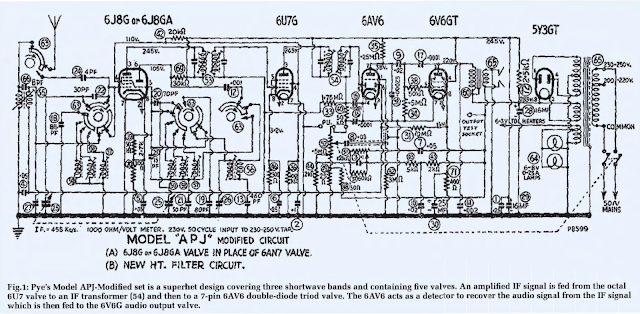Vintage Radio PYE 1951 5 valve page 1
Here is the video on the subject:
THE of Pye's MODEL Manufactured in 1951, it reflects the shortages imposed by World War 2 on Australian society at the time.
The first thing you notice is that the simple timber case is made of 5-ply timber. In this respect, contemporary timber cabinet Astors and STC radios both had similar minimalist construction techniques during the early 1950s.
The veneered cabinets have character but they don't really compare to the high-quality timber cabinets seen on pre-war radios.
Pye's model APJ is some 520mm wide, so it is quite a large mantel radio. It uses a fairly standard superhet circuit with a proven valve line-up and the only two real advances incorporated into the radio for the time are a thermo-mouldable plastic surround (i.e, not Bakelite) and a 6AV6 miniature valve.
As well as tuning the standard broadcast band, this radio also covers three shortwave bands and the dial shows the wavelengths on which major European world services could be heard. The colours on the dial conveniently correspond with the color coded wave change switch on the side of the radio, making it easy to select the desired band.
This was a time when "new Australians" from Europe were keen to maintain contact with their country of birth, so shortwave listening was popular. This pastime has now virtually ceased, as the internet and other media services have made shortwave services an anachronism. As revealed later, I accidentally confirmed just how little ofthe shortwave spectrum is now used for transmissions.
Circuit details
Fig.1 shows the circuit details of Pye's Model APJ Modified, as detailed in the Australian Official Radio Service Manual (AORSM) of 1951. As can be seen, the front-end is rather densely packed with the band-change coils and selection switches. The mixer-oscillator valve (6J8G) is at the core of all these circuits and provides a 455kHz IF signal which is then fed via the IF transformer (53) to an IF amplifier stage based on a 6U7G. There is no tuned RF amplification, so only a 2-gang tuning capacitor is required.
This is the "modified" version ofthe circuit but that doesn't reflect a later improvement to the original circuit. Instead, it's a reflection of the early 1950s when many commodities were in short supply. This was a time when bricks and cement were rationed for new home builders. Similarly, some valve types were hard to obtain.
The unmodified front-end circuit is shown in Fig.2 and this features a miniature 6AN7 valve as the converter. The Pye service notes state that "it was intended to use a converter valve type 6AN7 in the model APJ receiver. As supplies of this valve were not available at the time of production, a type 6J8 or 6J8A converter valve was used".
The 6J8 used in the radio described here is a conventional octal valve with a grid terminal at the top. The valve is fitted with an earthed goat shield to keep it stable and reduce interference; it was referred to as a goat shield, because it was made by a company called Goat Radio Tube Inc in the USA.
The service notes offer the following information: "the alterations made to use the 6J8 are as follows: (A) 60,000 Ohm resistor number 41 changes to 30,000 Ohms 1 watt and becomes number 69. (B) 6pF condenser 68 is deleted. (C) 4pF condenser 67 is deleted. (D) 200 Ohm resistor 47 changes to 200 Ohms 1/2 Watt and becomes component 70. (E) A valve shield part PN217 is required and a valve shield earth clip. (F) The 9-pin socket is changed to an 8-pin socket part PM532. (G) A grid clip part 873/495 is required for the 6J8 control grid".
The octal 6U7 IF amplifier that follows the 6J8 also has a close fitting goat shield. The 6U7 in this radio had a broken octal locating spigot. Fortunately, the earth-contact strap for the shield clearly indicates pin 1.
The amplified IF signal from the 6U7G is fed via a second IF transformer (54) to a 6AV6 double-diode triode valve. This valve is fitted to a 7-pin socket which in turn is attached to the chassis using an adapter that fits a hole punched for an octal valve. It is clear from the high number of punched holes in the APJ's chassis that this chassis was used as a platform for a range of products. In this set though, "APJ-846" is stamped into the chassis adjacent to the 6AV6 socket to aid
identification.
The 7-pinminiature 6AV6 has three functions: (1) it acts as a detector to recover the audio signal from the IF signal, (2) it rectifies the IF to produce an AGC signal and (3) the triode section acts as an audio preamplifier stage. The valve is supplied with a simple slip-on metal shield that's earthed with copper braid.
The recovered audio from the 6AV6's detector is fed to a 6V6G audio output valve. This is a large octal valve that was used in the majority of Australian radios from the late 1930s until the 1950s. It was also made as the physically more compact 6V6GT.
The 6V6 is designated as a beam power tetrode and was introduced by Ken-Rad in 1936. It was later superseded in the 1950s by the 6AQ5 (Mullard-Philips EL90), a miniature 7-pin valve with ratings virtually identical to the 6V6.
Although both variants of the APJ model had a primary HT of 285V, the modified variant changed the 6V6 cathode bias resistor from 300Q to 400Q to generate a higher negative grid bias. The presumably better placed the valve in its linear response range for less distortion. Certainly, this radio was capable of delivering a high volume with good fidelity.
An additional change for component economy in the modified APJ was to replace component 61, a 14 Henry 80mA choke, with two 5kQ resistors in parallel. The radio featured here has these resistors and these would be much cheaper than using a choke to help filter the HT from the 5Y3GT rectifier valve.
In this radio, a previous owner had replaced the two HT filter electrolytics. Both are specified as 16µF types on the circuit and both were housed in the same can on the top of the chassis. The replacement capacitors were 22µF 450V types and although the choke was absent (having been replaced with the resistors) the filtering was effective because hum was negligible.
Fortunately, the original capacitors had simply been disconnected from the circuit and the can left in place Rear view of the Model APJModified set and the base of an octal 6U7G IF amplifier. adjacent to the 6V6 output valve. The new capacitors were simply wired into place underneath the chassis.
The rectifier valve in this radio is a 5V4, rather than a 5Y3 as shown on the circuit. The 5V4 is pin-compatible with the 5Y3 but has less internal resistance. The circuit diagram indicates that the HT (high-tension voltage) from the rectifier should be 285V DC but with a 5V4 in place, the measured HT was 329V. The radio was designed for a 230VAC supply, so the higher 240VAC mains at my house also contributed to the elevated HT.
Inserting a 1.5kQ 5W resistor in series with pin 8 of the 5V4 brought the HT back to a more reasonable 280V.
This also eliminated occasional arcing (induced by the over voltage) that could be seen as flashes between the output transformer primary (at full HT) and the earthed secondary.And here a word of warning! If you come across one of these radios, note that the output transformer is mounted on an insulated stand-off from the chassis and its exposed metal frame is connected to the full HT (see Fig.1). The manufacturer provides no specific warning of the extreme danger, although a decal on the chassis does give a general warning as to the presence of high voltages.So why was the output transformer's frame connected to the HT? The reason is that connecting the transformer's frame to its primary (and thus to the HT from the rectifier) helps prevent electrolytic spot corrosion of the fine wire used in the winding.





Appreciation is a wonderful thing...thanks for sharing kepp it up. Azkapc.com
ReplyDeleteAutodesk 3ds Max Crack
4K Video Downloader Crack
TeamViewer Crack
TransMac Crack
Advanced SystemCare Pro Crack
Thanks for sharing keep it up i like your content links given below!
ReplyDeleteAUDIO AMPLIFIER Crack